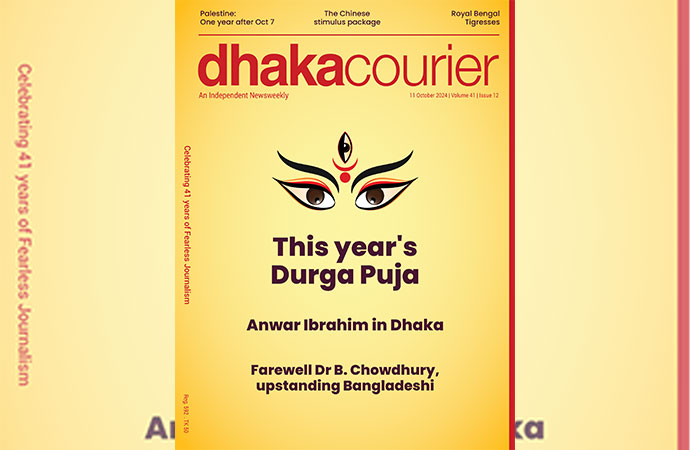Culture

I distinctly remember my introduction to Aminul Islam at his Gulbagh house in the city. The house was beautiful in its architectural patterns. His studio was spacious and people from every strata came over to see him and his works. Islam was soft-spoken, but bold and uncompromising in his stance.
The painter Nurul Islam (now deceased) took me to Aminul Islam's atelier. A few weeks after that, I went there and came across art critic Sadeque Khan (now deceased) and artist Ranjit Das. Islam was working on an oil painting. We chatted till midnight and various issues came to the fore. I interviewed Aminul Islam, which was published in the Weekly Holiday (edited by veteran journalist A.Z.M. Enayetullah Khan). In that interview, Islam said, "Painters are of two kinds - one group works with emotions and the other works with intelligence. I am at the centre as both aspects are inherent in me."
Aminul Islam was one of the senior most and acclaimed painters in our country. He made a vast contribution by introducing modern paintings in Bangladesh. He gradually changed his styles, and established himself as a significant painter in Bangladesh. Passionate and imaginative, Islam shied away from overexposure and any commercial lure. He was a workaholic and believed in fine creations. He was extremely cordial and supportive, particularly towards promising painters.Islam's only son's sudden death changed him overnight. He became quieter than usual and seemed to have a different outlook towards life altogether. He sold the house in Gulbagh and donated the money to a numbe r of charities. Some of that money went into the creation of a fund for underprivileged, talented students of fine arts.
Among Islam's contemporaries were Hamidur Rahman, Bazle Moula, Imdad Hossain, Khaled Chowdhury, Loknath Dhor and Ali Humayun (first batch of the Government College of Arts and Crafts in 1948 -- later renamed Faculty of Fine Arts, University of Dhaka). The group was very committed and most of them were involved in left leaning politics. Their preferred themes were nature, urban life and surrounding atmosphere. At the time, Dacca (now Dhaka) was a quiet city and it had lots of green spaces. Painters frequently visited the Buriganga river, Waiz Ghat and other scenic places for inspiration. Zainul Abedin particularly stressed on drawing and successfully gave Islam and his comrades an understanding of this genre of art and its various significant aspects. The students also portrayed political chaos, economic crises, city life, rural life, still life and other subjects. Some of them were greatly influenced by internationally acclaimed impressionist painters.
Among his contemporaries, Islam made a vast contribution by introducing modern paintings in Bangladesh. "Painting, for me, is the best way to knowledge, the best means to participate profoundly in the global life," Islam used to say.
On completion of his primary education, Islam gained admission to Armanitola High School. He started copying Japanese and Chinese art in school. He would also copy Indian painters' works. He appreciated the cubist and semi-cubist works of Gagendranath Tagore. However, his parents did not want him to take up painting as a profession.
After his matriculation in 1947, he sought admission in Calcutta Art College. While in Calcutta (now Kolkata), he met Zainul Abedin, Quamrul Hassan and Safiuddin Ahmed. They suggested that he avoided seeking admission in Calcutta Art College as an art college was to be established in Dhaka very soon. Islam returned to Dhaka with Zainul Abedin. However, since there was no sign of any art college yet, he took admission in Dacca College.
The Government Institute of Art opened in 1948. Islam got admitted there and completed his BFA. Then he went to Florence, Italy to pursue higher studies in art. His three years there proved very formative, as he found answers to many of his questions about art and aesthetics. After moving back to Dhaka, Islam's style underwent a fundamental change. Lines, colours and space became the prime focus in his paintings. Throughout his chequered career, he frequently returned to nature for inspiration.
Islam grew primarily as a non-figurative painter in the early 1960s and started to experiment with different mediums and art forms. Besides painting, Islam was also inclined towards drawing. In the course of his career, he developed several styles, particularly in his drawings and sketches. His figure-based works from the mid-1960s are remarkable; mainly "Homage to Khajuraho", an erotic drawing series focusing on the physical relationship between men and women.
Gradually Islam became increasingly aware of the different qualities of lines produced by pen, pencil, brush, bamboo, discarded brush and other objects. The powerful drawings reveal his mastery over lines and superb composition skills. He also did murals in different parts of the country. The artist died in 2011.

























Leave a Comment
Recent Posts
In stormy seas, they steadied ...
As the interim government of Nobel Laureate Prof. Muhammad Yunus compl ...
Why the Munia Murder case must ...
It was late in the afternoon of April 26 in 2021, just after 3pm, that ...
Bangladesh and India are preparing for a high-level ..
Dr Yunus sees ill-efforts at home, abroad to make go ..
Desired elections on completion of necessary reforms ..
Pope Francis has called for an investigation to dete ..